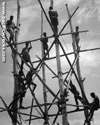|
|
|
|
| Missing In Action (MIA) | Prisoners Of War (POW) | Unexploded Ordnance (UXO) |
| Chronology | Locations | Aircraft | Ships | Submit Info | How You Can Help | Donate |
|
 USAAF Sept 9, 1943  USAAF c1944   Roberts 1947   Justin Taylan 2004 |
Location Nadzab No. 2 Airfield is located near Nadzab in the Markam Valley in New Guinea. To the south is the Markham River and Nadzab. Further to the southeast is Lae. Also known as "Nadzab No. 2", "No. 2 Strip" or "East Base". Today located in Morobe Province in Papua New Guinea (PNG). Still in use today as part of "Nadzab Airport" or "Nadzab Lae Airport". Wartime History During early 1942, occupied by the Japanese with only occasional Japanese Army patrols through the area. Some references incorrectly show a Japanese emergency strip at this location. In fact, there was no airfield was built at this location. On September 5, 1943 Allied paratroopers from the U.S. Army 503rd Parachute Infantry Regiment (503rd PIR) and Australian Army 2/4th Field Gun Volunteers landed with short barrel 25 pounders made a successful parachute drop in the area. On the ground, they met met little resistance. This was the only Allied paratrooper assault in New Guinea. Construction During September 1943, built by the U.S. Army as two parallel runways (Nadzab No. 1 Airfield (No. 1 Strip) to the north and Nadzab No. 2 Airfield (No. 2 Strip) to the south nearest to the Markham River. The runways were oriented northwest to southeast surfaced with marston matt / Pierced Steel Planking (PSP) and was rapidly developed into a massive airbase complex. Nadzab based U.S. Army Air Force (USAAF) and Royal Australian Air Force (RAAF) planes and staging base. Designated U.S. Army Post Office 713 / APO 713 (Nadzab). American and Japanese missions against Nadzab March 23, 1943–November 9, 1943 American units based at Nadzab Based at Nadzab Airfield No. 1, No. 2, No. 3 and No. 4 Towards the end of the Pacific War, the 21st Air Depot Unit at Nadzab was a bone yard for scrapped planes and salvage area for repairs. The Far East Air Force - Combat Replacement and Training Center (FEAF-CRTC) operated until June 30, 1945. Post War Scrapping Most of the wrecks at Nadzab were scraped immediately after the war, permits being awarded to private contractors who were given rights to scrap aircraft, sell aviation fuel and oil. As early as September of 1945, hundreds of wrecks were scrapped by a private Australian smelting company. Two expatriates involved with the scrapping were Eric Snook(s) and Arthur Scott. Although most wartime wreckage was scrapped or otherwise disappeared According to Charles Darby, in the mid 1970's other wreckage remained, including a Stinson L-1 and 11 Hadrian gliders. Today The former 'East Base' or No. 1 & No. 2 runways are still in use today as "Nadzab Airport" or "Nadzab Lae Airport". Used by Air Niugini and other aviation companies. The runway measures 2438m x 30m at an orientation of 09/27 at an elevation of 231'. Airport codes: ICAO: AYNZ and IATA: LAE. Nearly every road in the area was built by American forces, and even as you land at Nadzab today, you can still see WWII era taxiways in the overgrown areas outside the airport area. References Engineers in Theater Operations [Pacific] "Advance Area Airdromes 31 January 1944", Map No. 24 Contribute
Information Last Updated
|
Map 1944 Map Fallingrain Nadzab #2 View on Google Earth Photo Archive |
| Discussion Forum | Daily Updates | Reviews | Museums | Interviews & Oral Histories |
|